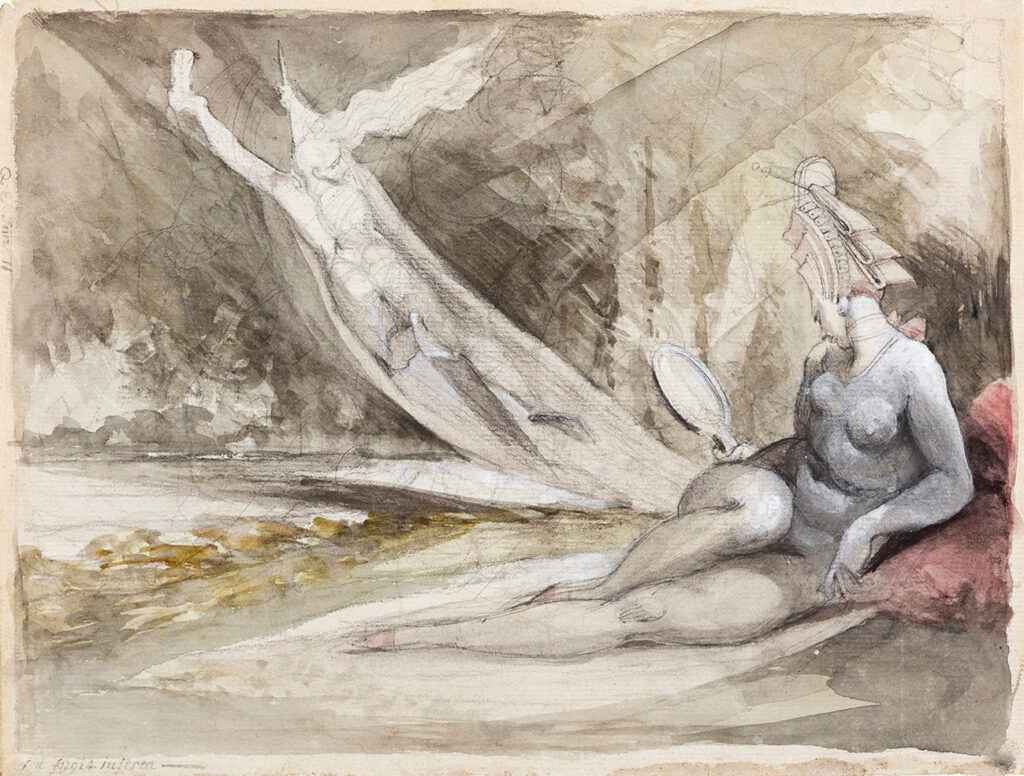Henry Fuseli was, with his admirer William Blake, the most singular figure in British art in the late 18th and early 19th centuries. His paintings of Shakespearean scenes, Norse myth and the supernatural combined the linearity and purity of form of neoclassicism with the unbridled imagination of burgeoning romanticism, and titillated, shocked and intrigued his contemporaries. The painting that made his name was The Nightmare (1781), a boudoir scene in which a young woman lies on a bed, suggestively supine, with an incubus sitting on her belly and a ghostly horse pushing through the curtains. It gave form to the entwined themes of sex, death, the supernatural and the unconscious: Sigmund Freud supposedly kept a print of it in his apartment.
Fuseli (1741-1825) was a complicated man who divided opinion. He was born Johann Heinrich Füssli in Switzerland, received a classical education – he knew ancient Greek, Latin, French, Italian, German and English – took holy orders and was forced to flee Switzerland after exposing a corrupt official. He came to England intending to become a poet but turned to art on the advice of Sir Joshua Reynolds, president of the Royal Academy (RA), who told him he had the ability to become “the greatest painter of his age”. Fuseli spent eight years in Rome, imbibing the antique and Michelangelo at source, and on his return to England eventually became professor of painting at the RA and then Keeper.
To his admirers he was sui generis. His friend the philosopher and physiognomist Johan Caspar Lavater wrote that: “He is always extreme – always original… He cannot draw in a single breath of common air.” Detractors found him deeply flawed, both his ego – William Godwin, whose wife-to-be Mary Wollstonecraft had made a play for the painter, called him “the most frankly ingenuous and conceited man I ever knew” – and his want of painterly decorum. The Royal Academician and critic Edward Dayes, who lamented that Fuseli’s “heat is not tempered with the coolness and judgement necessary to an artist”, was not alone.

Woman in a Sculpture Gallery (1798)
The most extreme examples of his art, however, were known only to members of his intimate circle and a few connoisseurs with niche interests. Throughout his life he made private drawings that show predominantly women with elaborate hairstyles, scenes of copulation or combinations of both. A remarkable selection of his highly charged coiffure drawings is now on display in “Fuseli and the Modern Woman: Fashion, Fantasy, Fetishism” at the Courtauld Gallery.
The 50 drawings are not straightforward images chronicling Fuseli’s fascination with women’s hair, but enigmatic pictures that suggest yet never explain his psychological motivations. Sometimes the outrageously complicated hairstyles sported by his women ape those in fashion plates of the time, at others they seem exercises in invention. Most, however, have an unmistakable erotic undertow that only increased after 1788 when he married an artists’ model named Sophia Rawlins.
[See also: Van Gogh would have loved his soup-covered Sunflowers – and so should we]
In her, Fuseli found someone who shared his tastes, and numerous pictures show Sophia with toppling, organic, convoluted hairdos that may be imaginary or may have been of her own devising. Her hair – and those of the femmes fatales and Medusa figures who people his pictures – symbolises female agency. His women are always aware of their sexual power and are dominatrices to a greater or lesser degree.
In many of the drawings, Sophia and Fuseli exchange knowing looks, a shared intimacy both domestic and sexual, as her face and preternaturally long neck act as a plinth for sculptural hair arrangements that foam with curls, plaits, sweeps, swags and bobbles. Both seem to have found them exciting. The Fuselis had a hairdresser attend them every morning and went to the theatre most nights, so were well versed in contemporary fashion and kept their end up, too.

Most of Fuseli’s pornographic drawings were burned by Sophia after his death but one in the exhibition, showing a man being explicitly subsumed by three women sporting baroque updos, is simultaneously morbid and erotic. This was the age of the Marquis de Sade and there is some discussion as to whether Fuseli knew his work; nevertheless, here is a man being murdered by coitus. Other drawings are less overt: numerous come-hither bottoms confront the spectator; women turn their heads and gesture, inviting the viewer to follow; others are engaged in activities that never quite materialise but seem both intriguing and sinister; courtesans sit behind balconies or in theatre boxes.
On a drawing of a woman with a broad hat of c1795, Fuseli wrote in Greek: “Restlessly I chased the image of my dream through the passing fashions.” It is a not-quite-key to these endlessly interpretable and piquing images in which hair and sex were so tightly braided.
Fuseli and the Modern Woman: Fashion, Fantasy, Fetishism
The Courtauld Gallery,
Somerset House, London WC2
Runs until 8 January 2023
[See also: How Battersea Power Station became a palace of consumerism]
This article appears in the 26 Oct 2022 issue of the New Statesman, State of Disorder






